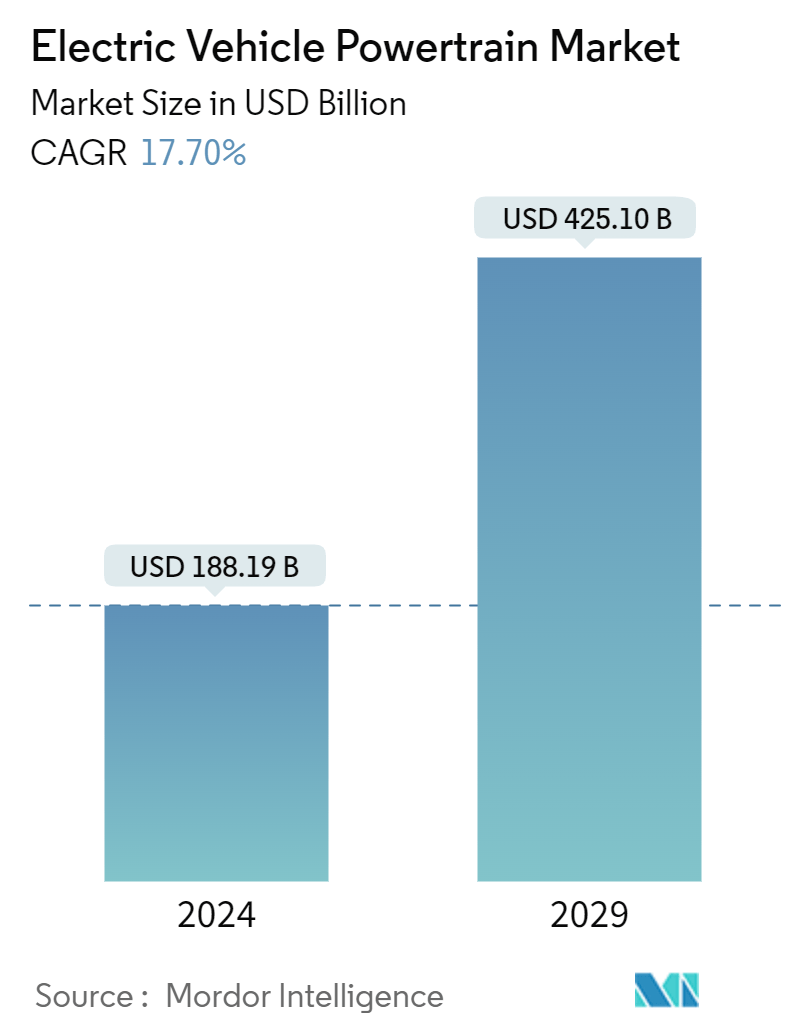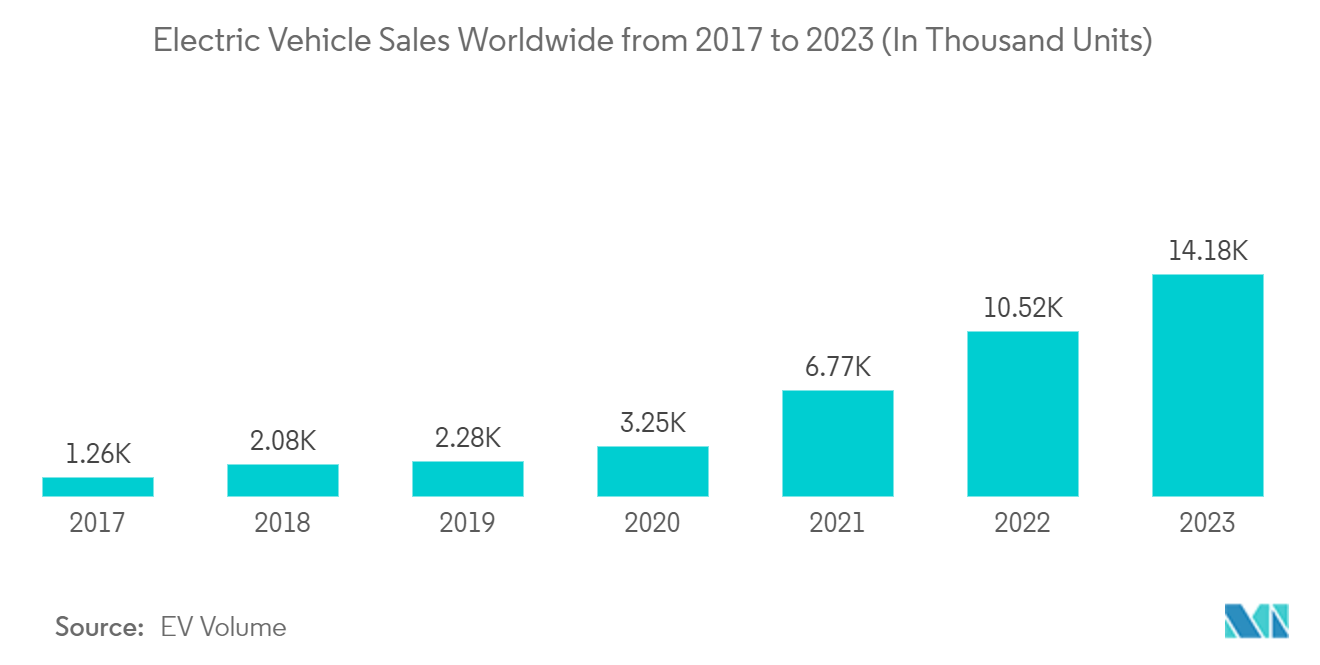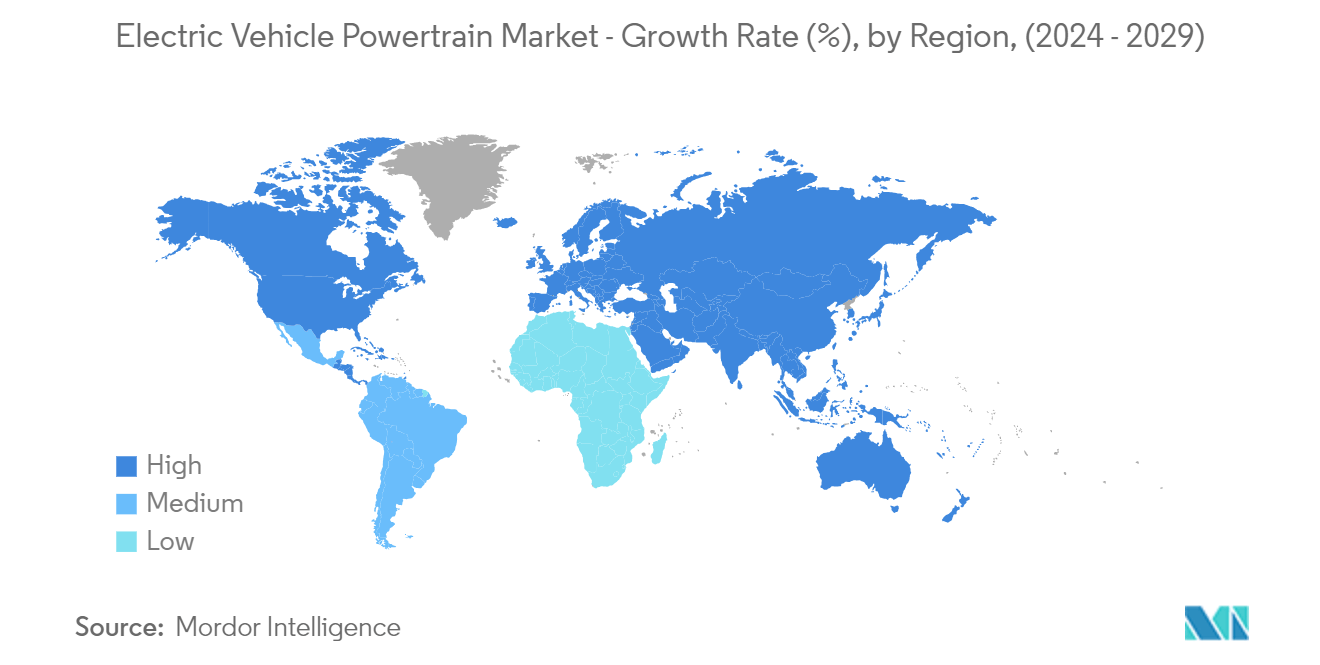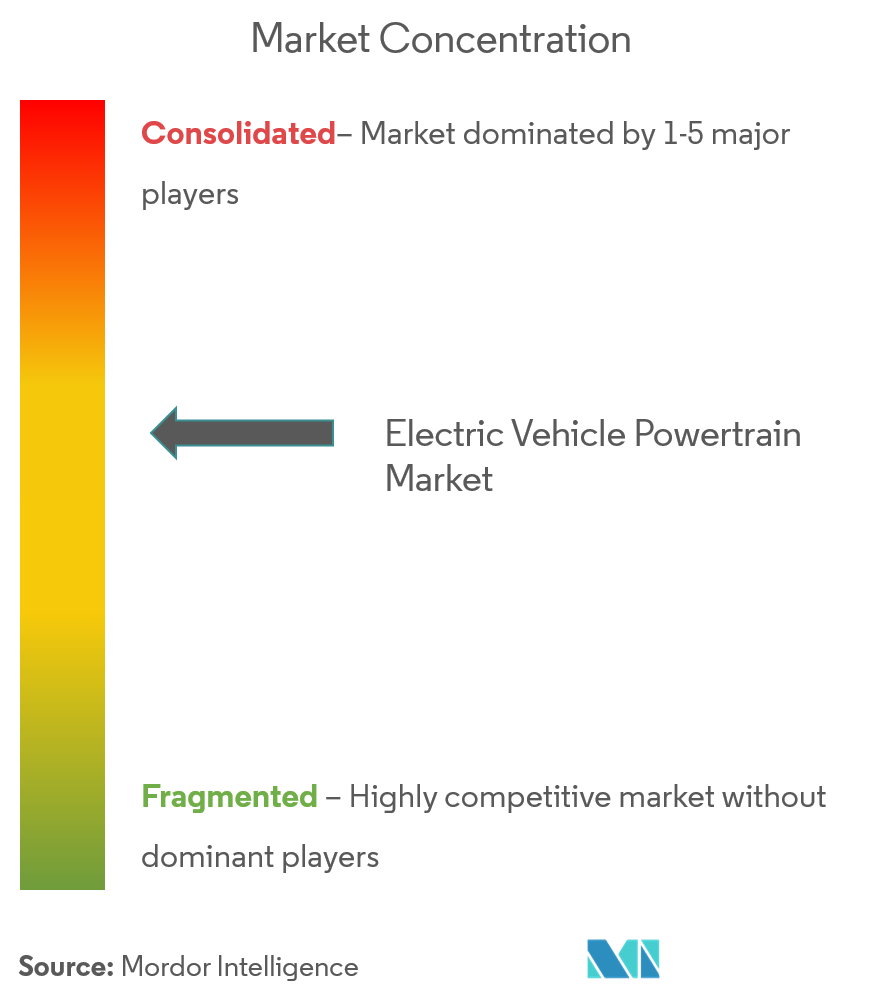Electric Vehicle Powertrain Market Size

| Study Period | 2019 - 2029 |
| Market Size (2024) | USD 188.19 Billion |
| Market Size (2029) | USD 425.10 Billion |
| CAGR (2024 - 2029) | 17.70 % |
| Fastest Growing Market | Asia Pacific |
| Largest Market | Asia Pacific |
Major Players
*Disclaimer: Major Players sorted in no particular order |
Electric Vehicle Powertrain Market Analysis
The Electric Vehicle Powertrain Market size is estimated at USD 188.19 billion in 2024, and is expected to reach USD 425.10 billion by 2029, growing at a CAGR of 17.70% during the forecast period (2024-2029).
The electric vehicle (EV) powertrain market is experiencing unprecedented growth, driven by the global shift toward sustainable transportation, technological advancements, and supportive government policies. This market encompasses the components and systems that generate power and deliver it to the wheels of an electric vehicle, including the battery, electric motor, power electronics, transmission, and other related systems.
The primary driver of the EV powertrain market is the increasing demand for electric vehicles, propelled by the urgent need to reduce greenhouse gas emissions and combat climate change. Governments across the world are implementing stringent emissions regulations and offering incentives to encourage the adoption of EVs. For instance, countries like Norway, Germany, and China provide substantial subsidies, tax benefits, and other incentives to promote EV sales, significantly boosting the powertrain market.
Technological advancements play a crucial role in the growth of the EV powertrain market. Innovations in battery technology, such as the development of solid-state batteries and improvements in lithium-ion battery efficiency, are enhancing the range, performance, and affordability of electric vehicles. Additionally, advancements in electric motors, inverters, and power electronics contribute to more efficient and powerful EV powertrains.
Continued government support through incentives, subsidies, and infrastructure investments is expected to the market's growth. Policies aimed at reducing carbon emissions and promoting sustainable transportation will further accelerate the adoption of electric vehicles. Moreover, ongoing research and development are expected to lead to breakthroughs in battery technology, electric motors, and power electronics. Innovations such as solid-state batteries, wireless charging, and advanced power management systems are expected to enhance the performance and appeal of electric vehicles.
Driven by technological advancements, supportive government policies, and increasing consumer demand for eco-friendly vehicles, the market is set for substantial growth.
Electric Vehicle Powertrain Market Trends
Increasing Sales of Battery Electric Vehicles is Driving the Market's Growth
In 2023, global electric car sales reached a remarkable 3.5 million units higher than the previous year, marking a substantial 35% Y-o-Y increase. This surge in sales highlights the accelerating shift toward electric mobility, influenced by several key factors. Notably, this figure is more than six times higher than the sales recorded in 2018, underscoring the rapid adoption of electric vehicles over the past five years. The significant growth trajectory can be attributed to technological advancements, government incentives, and changing consumer preferences.
The primary driver behind the increasing sales of BEVs is the continuous advancement in battery technology. Innovations in battery chemistry and manufacturing processes have significantly improved energy density, charging speed, and overall performance. These advancements have made BEVs more appealing to consumers by addressing concerns related to range anxiety and charging times. Moreover, the cost of lithium-ion batteries has been steadily declining, making electric vehicles more affordable and competitive with traditional internal combustion engine vehicles.
The increasing sales of BEVs are directly driving the growth of the electric vehicle powertrain market. Powertrain, which includes components such as the battery, electric motor, power electronics, and transmission, is a crucial element of an electric vehicle. As sales of electric vehicles rise, the demand for these powertrain components also increases, leading to market expansion. Manufacturers are focusing on enhancing the efficiency and performance of powertrain systems to meet the increasing demand and stay competitive.
Furthermore, the automotive industry is witnessing a shift toward developing advanced powertrain technologies. Companies invest in research and development to innovate and improve electric powertrain systems.
For instance, in July 2023, Volvo Trucks Malaysia introduced the region's first fully electric Heavy Duty Prime Mover. The Volvo FH Electric, FM Electric, and FMX Electric models are powered by an electric powertrain with two or three motors producing up to 490 kW and 2,400 Nm of torque depending on the application, and battery capacity ranging from 180 kWh to 540 kWh from two to six battery packs, claiming up to 300 km of travel range on a single full charge at 44 tons gross combination weight (GCW).

Asia-Pacific is Expected to Dominate the Market
Asia-Pacific is at the forefront of the electric vehicle (EV) powertrain market, outpacing other regions in terms of production, adoption, and technological advancement.
Asia-Pacific's leadership in the EV powertrain market is aggressive with governmental policies and initiatives promoting electric mobility. Countries such as China, Japan, and South Korea have implemented a series of incentives, subsidies, and regulations to encourage the adoption of electric vehicles. For instance, the Chinese Government offers substantial subsidies for EV purchases, mandates EV production quotas for automakers, and supports the development of charging infrastructure. These policies have significantly boosted the market for electric vehicles and, by extension, the powertrain components that drive them.
China, in particular, is a powerhouse in the EV market. The country is home to some of the largest EV manufacturers globally, such as BYD, NIO, and Xpeng Motors, which contribute significantly to the production and sales of electric vehicles. The presence of these manufacturers has established a robust supply chain for electric vehicle powertrain components, including batteries, motors, and power electronics. This localized production capability reduces costs and enhances the competitiveness of Chinese EV manufacturers on the global stage.
Furthermore, Asia-Pacific benefits from advanced manufacturing capabilities and technological expertise. Japan and South Korea are leaders in battery technology, with companies like Panasonic, LG Chem, and Samsung SDI driving innovations in lithium-ion battery production. These companies supply high-quality batteries to EV manufacturers across the world, ensuring the reliability and performance of electric vehicle powertrains. The continuous improvement in battery technology, including increased energy density and reduced costs, has been a critical factor in the growing adoption of electric vehicles.
Another factor contributing to Asia-Pacific's dominance is the increasing consumer demand for electric vehicles. The rising awareness of environmental issues, the growing urbanization, and the need to reduce air pollution have led to a surge in demand for cleaner transportation options. Consumers in major cities across China, Japan, and South Korea are increasingly opting for electric vehicles, driven by both environmental concerns and the availability of government incentives.
As the global market for electric vehicles continues to grow, Asia-Pacific is expected to maintain its leadership position, driving further advancements in EV powertrain technologies and shaping the future of electric mobility.

Electric Vehicle Powertrain Industry Overview
Few players, such as Robert Bosch GmbH, ZF Friedrichshafen AG, Cummins Inc., Dana Incorporated, GKN PLC, and Magna International, dominate the electric vehicle powertrain market. The players are making partnerships, acquisitions, launching new products, and investing to be ahead of the competition.
June 2023: Zhongshan Broad-ocean Motor Co. Ltd announced plans to build the "Broad-ocean Motor New Energy Vehicle Powertrain System and Parts (Chongqing) R&D and Manufacturing Site" in Chongqing's Yubei District. The project is planned to have a project company established in an area under the jurisdiction of the Chongqing Innovation Economy with a total investment of about CNY 1 billion (USD 139.9 million) and a land area of about 73,333 sq.m.
Electric Vehicle Powertrain Market Leaders
-
GKN PLC
-
Magna International
-
Hitachi Automotive Systems Ltd
-
Robert Bosch
-
Cummins Inc.
*Disclaimer: Major Players sorted in no particular order

Electric Vehicle Powertrain Market News
- April 2023: Modern Automotives became the first Indian company to receive approval for deliveries of Differential Pinion Shafts to BMW AG Munich for the electric powertrain. The order anticipates delivering 2.5 million units by 2034.
- July 2023: Mercedes-Benz introduced the all-new AMG performance version of its GLC SUV. The powertrain is designed and built in Germany at the Affalterbach plant.
- June 2023: Lucid Group Inc. announced a technology partnership with Aston Martin to provide Aston Martin with Lucid-engineered and manufactured electric powertrain technology to power future Aston Martin battery electric vehicles (BEV). It has an ultra-twin motor drive unit, battery technology, and the Wunderbox, Lucid Motors onboard charging unit. It will contribute to introducing the first pure electric Aston Martin model in 2025. Aston Martin's all-new in-house Battery Electric Vehicle (BEV) platform will be built around access to Lucid's current and future powertrain and battery technology.
EV Powertrain Market Report - Table of Contents
1. INTRODUCTION
- 1.1 Study Assumptions
- 1.2 Scope of the Study
2. RESEARCH METHODOLOGY
3. EXECUTIVE SUMMARY
4. MARKET DYNAMICS
-
4.1 Market Drivers
- 4.1.1 Increasing Sales of Electric Vehicles are Expected to Drive the Market
-
4.2 Market Restraints
- 4.2.1 Lack of Infrastructure May Hamper the Market's Growth
-
4.3 Industry Attractiveness - Porter's Five Forces Analysis
- 4.3.1 Threat of New Entrants
- 4.3.2 Bargaining Power of Buyers/Consumers
- 4.3.3 Bargaining Power of Suppliers
- 4.3.4 Threat of Substitute Products
- 4.3.5 Intensity of Competitive Rivalry
5. MARKET SEGMENTATION
-
5.1 Component
- 5.1.1 Transmission
- 5.1.2 Motors
- 5.1.3 Battery
-
5.2 Propoulsion Type
- 5.2.1 Battery Electric Vehicle
- 5.2.2 Plug-In Hybrid Electric Vehicle
-
5.3 Vehicle
- 5.3.1 Passenger Car
- 5.3.2 Commercial Vehicle
-
5.4 Geography
- 5.4.1 North America
- 5.4.1.1 United States
- 5.4.1.2 Canada
- 5.4.1.3 Rest of North America
- 5.4.2 Europe
- 5.4.2.1 Germany
- 5.4.2.2 United Kingdom
- 5.4.2.3 France
- 5.4.2.4 Norway
- 5.4.2.5 Rest of Europe
- 5.4.3 Asia-Pacific
- 5.4.3.1 China
- 5.4.3.2 Japan
- 5.4.3.3 India
- 5.4.3.4 South Korea
- 5.4.3.5 Rest of Asia-Pacific
- 5.4.4 Rest of the World
- 5.4.4.1 South America
- 5.4.4.2 Middle East and Africa
6. COMPETITIVE LANDSCAPE
- 6.1 Vendor Market Share
-
6.2 Company Profiles*
- 6.2.1 GKN PLC (Melrose Industries PLC)
- 6.2.2 Magna International Inc.
- 6.2.3 Hitachi Automotive Systems Ltd
- 6.2.4 Bosch Limited
- 6.2.5 Cummins Inc.
- 6.2.6 AVL List GmbH
- 6.2.7 Mitsubishi Electric Corp
- 6.2.8 BorgWarner Inc.
7. MARKET OPPORTUNITIES AND FUTURE TRENDS
** Subject To AvailablityElectric Vehicle Powertrain Industry Segmentation
A powertrain is a set of components that generate power to move the vehicle. The electric powertrain encompasses the battery and electric motor. It offers transmission of power, which is used to produce the power that is further utilized to drive or move the vehicle. The electric powertrain of a vehicle is defined by its performance, comfort, and safety.
The EV powertrain market is divided into segments based on component type, including transmission, motors, and battery. Furthermore, it's categorized by propulsion type, distinguishing between battery electric vehicles and plug-in hybrid electric vehicles. Additionally, the market is segmented by vehicle type, covering passenger cars and commercial vehicles. Lastly, the geographical aspect includes North America, Europe, Asia-Pacific, and the Rest of the World.
The report offers market size and forecasts for the electric vehicle powertrain market in terms of value (USD) for all the above segments.
| Component | Transmission | |
| Motors | ||
| Battery | ||
| Propoulsion Type | Battery Electric Vehicle | |
| Plug-In Hybrid Electric Vehicle | ||
| Vehicle | Passenger Car | |
| Commercial Vehicle | ||
| Geography | North America | United States |
| Canada | ||
| Rest of North America | ||
| Geography | Europe | Germany |
| United Kingdom | ||
| France | ||
| Norway | ||
| Rest of Europe | ||
| Geography | Asia-Pacific | China |
| Japan | ||
| India | ||
| South Korea | ||
| Rest of Asia-Pacific | ||
| Geography | Rest of the World | South America |
| Middle East and Africa |
EV Powertrain Market Research FAQs
How big is the Electric Vehicle Powertrain Market?
The Electric Vehicle Powertrain Market size is expected to reach USD 188.19 billion in 2024 and grow at a CAGR of 17.70% to reach USD 425.10 billion by 2029.
What is the current Electric Vehicle Powertrain Market size?
In 2024, the Electric Vehicle Powertrain Market size is expected to reach USD 188.19 billion.
Who are the key players in Electric Vehicle Powertrain Market?
GKN PLC, Magna International, Hitachi Automotive Systems Ltd, Robert Bosch and Cummins Inc. are the major companies operating in the Electric Vehicle Powertrain Market.
Which is the fastest growing region in Electric Vehicle Powertrain Market?
Asia Pacific is estimated to grow at the highest CAGR over the forecast period (2024-2029).
Which region has the biggest share in Electric Vehicle Powertrain Market?
In 2024, the Asia Pacific accounts for the largest market share in Electric Vehicle Powertrain Market.
What years does this Electric Vehicle Powertrain Market cover, and what was the market size in 2023?
In 2023, the Electric Vehicle Powertrain Market size was estimated at USD 154.88 billion. The report covers the Electric Vehicle Powertrain Market historical market size for years: 2019, 2020, 2021, 2022 and 2023. The report also forecasts the Electric Vehicle Powertrain Market size for years: 2024, 2025, 2026, 2027, 2028 and 2029.
EV Powertrain Industry Report
The EV Powertrain Market Report is segmented by component type, propulsion type, vehicle type, and geography. The report offers market size and forecasts for electric vehicle powertrains in terms of value for all the above segments. The analysis includes a market forecast outlook and historical overview. Statistics for the electric vehicle powertrain market share, market size, and revenue growth are provided. Market trends, market segmentation, and market value are examined in detail.
Industry reports highlight the market growth and market forecast for the electric vehicle powertrain sector. This industry analysis covers industry size, industry trends, and industry statistics, providing a comprehensive market overview. The market report includes insights into market leaders and market outlook, offering a thorough industry review.
Market research and market data from research companies are utilized to provide an in-depth industry outlook. The market predictions and industry sales data are included in the report example, which is available as a report PDF for further review. Industry information and industry research are crucial for understanding the market dynamics and future market growth.
The report covers industry trends and market forecast to offer a detailed market analysis. Additionally, market leaders and market outlook are discussed to provide a complete picture of the market landscape. The industry statistics and market segmentation are explored to understand the market size and growth rate.
In summary, the electric vehicle powertrain market report provides a comprehensive industry overview, including industry reports, industry research, and market analysis. The report example, available as a report PDF, includes market data, market predictions, and market review. The industry information and industry outlook are essential for understanding the market value and future industry trends.



